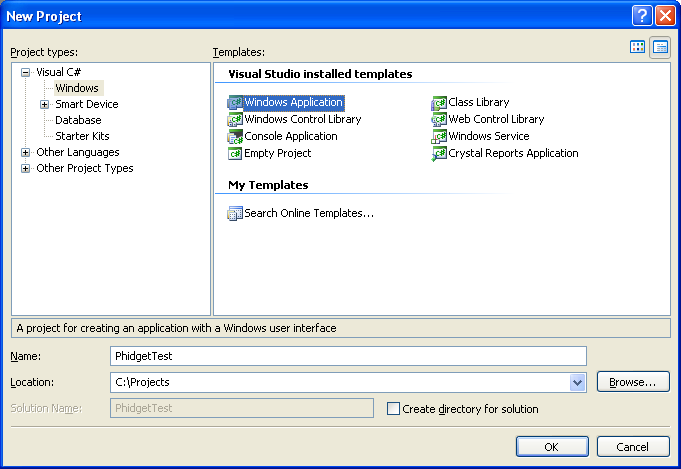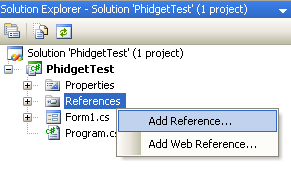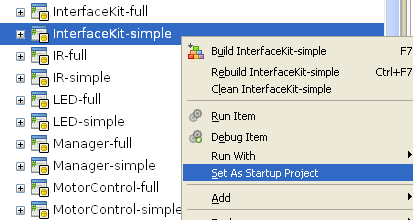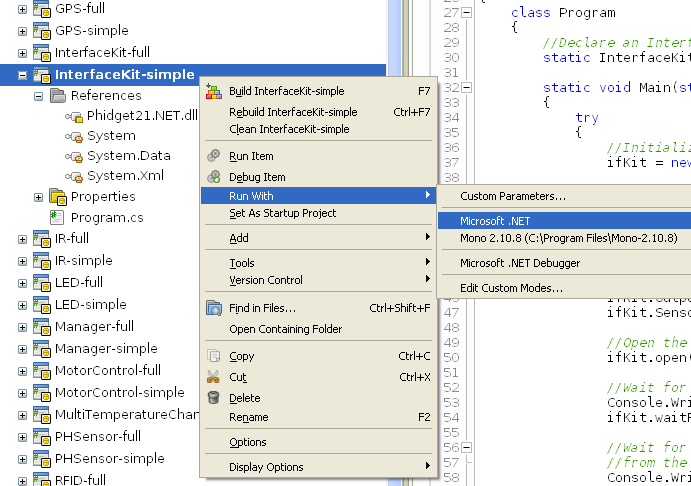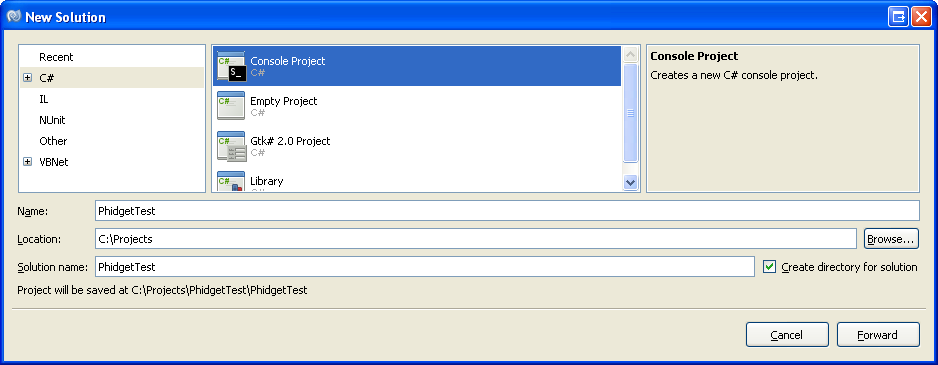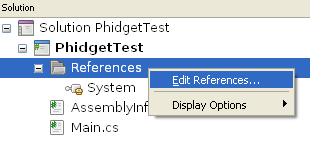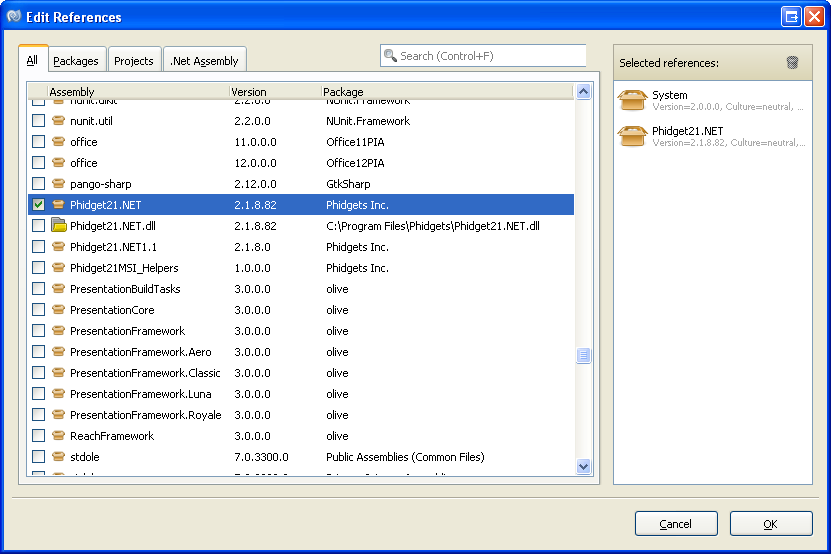Language - Java: Difference between revisions
No edit summary |
No edit summary |
||
| Line 1: | Line 1: | ||
[[File:icon- | [[File:icon-CSharp.png|64x64px|link=Language - Java]]Java is a modern, object-oriented programming language developed by Oracle. | ||
__TOC__ | |||
==Introduction== | |||
{{LanguageSupport|Java|the complete Phidget API, including events|all Phidget devices.}} | |||
== | ==Quick Downloads== | ||
Just need the Java drivers, libraries, and examples? Here they are: | |||
Java API Documentation: | |||
*[http://www.phidgets.com/documentation/JavaDoc.zip C# API Manual Download] or [http://www.phidgets.com/documentation/web/javadoc/index.html (HTML online version)] | |||
*[[General API]] (more help on functions common to all Phidgets) | |||
*[[Device List | Device Specific APIs]] (more help on functions specific to your Phidget) | |||
Java Example Code: | |||
*[http://www.phidgets.com/downloads/examples/JavaJNI_2.1.8.20111220.zip Java Example Code] | |||
Libraries and Drivers: | |||
*[http://www.phidgets.com/downloads/libraries/phidget21jar_2.1.8.20111220.zip phidget21.jar] | |||
*[http://www.phidgets.com/downloads/libraries/libphidget_2.1.8.20111028.tar.gz General Linux Libraries] ([[OS - Linux | Linux Library Setup Instructions]]) | |||
*[http://www.phidgets.com/downloads/libraries/Phidget_2.1.8.20111103.dmg General Mac OSX Libraries] ([[OS - Mac OS X | Mac OS X Library Setup Instructions]]) | |||
==Getting started with Java== | |||
If you are new to writing code for Phidgets, we recommend starting by running, then modifying existing examples. This will allow you to: | |||
{{ExampleCodeReasons}} | |||
Instructions are divided up by operating system. Choose: | |||
*[[#Windows(2000/XP/Vista/7)|Windows 2000 / XP / Vista / 7]] | |||
*[[#Mac OS X |Mac OS X]] | |||
*[[#Linux | Linux]] (including PhidgetSBC) | |||
==Windows(2000/XP/Vista/7)== | |||
===Libraries=== | |||
*[http://www.phidgets.com/downloads/libraries/phidget21jar_2.1.8.20111220.zip phidget21.jar] | |||
== | ===Description=== | ||
Java programs on Windows depend on the following files, which the installers above put onto your system: | |||
* <b><code>phidget21.dll</code></b> contains the actual Phidgets library, which is used at run-time. If you used our installer, it's already correctly placed in <code>C:\Windows\System32</code>. It can be manually installed - check our [[Manual Installation instructions]]. | |||
You will also need one of the following two files, depending on the .NET framework version you are targeting: | |||
* <b><code>phidget21.jar</code></b> is the Phidgets library for Java runtime <i><b>2.0</b></i> or higher. Your compiler has to know where this file is. By default, our installer puts this file into <code>C:\Program Files\Phidgets</code>. So, you can either point your compiler to that location, or copy and link to it in a directory for your project workspace. For more information, please see the section for your specific compiler/environment. If you do not want to use our installer, you can get the file [[#Libraries | here]]. | |||
Running the examples and writing your own code can be fairly compiler-specific, so we include instructions for each compiler below. | |||
===Command line=== | |||
Please start by downloading the Java Examples. The full examples were written in NetBeans. But Eclipse will easily open it. | |||
*[http://www.phidgets.com/downloads/examples/JavaJNI_2.1.8.20111220.zip Java Examples] | |||
=====Use Our Examples===== | |||
To run the examples, you first download them [[#Command line|from above]] and unpack them into a folder. To load all projects in Visual Studio, go to File | Open | Project, and open <code>AllExamples/AllExamples.sln</code> or <code>AllExamples/AllExamples_vs2008.sln</code> for Visual Studio 2005 and 2008, respectively. | |||
If you are opening the Phidget examples in Visual Studio 2010, you will need to go through the Visual Studio Conversion Wizard to convert the 2005 or 2008 project. | |||
<br/><br/>[[File:VS2005 Conversion Wizard.PNG]]<br/><br/> | |||
This will load all of the examples available for C#, and then you can set your main project to be the one that matches your device. If you aren't sure what the software example for your device is called, check the software object listed in the [[Device List | Getting Started guide for your device]]. | |||
The | The only thing left to do is to run the examples! Click on Debug -> Start Debugging. Please note that the projects, by default try to find the <code>Phidget21.NET.dll</code> in the <code>C:\Program Files\Phidgets</code>. If you have it installed in another location, please change the path accordingly. If you are receiving an error message regarding that the namespace Phidgets cannot be found, please re-add the reference to <code>Phidget21.NET.dll</code>. Please see the [[#Write Your Own Code | next section]] for details. | ||
<br/><br/> | |||
[[File:CSharp VS2005 Run.PNG ]] | |||
<br/><br/> | |||
Once you have the C# examples running, we have a [[#Follow The Examples|teaching section]] below to help you follow them. | |||
=== | =====Write Your Own Code===== | ||
When you are building a project from scratch, or adding Phidget function calls to an existing project, you'll need to configure your compiler / development environment to properly link the Phidget C# libraries. To begin: | |||
* Generate a new Visual C# Windows Applications project with a descriptive name such as PhidgetTest. | |||
< | <br/>[[File:CSharp VS2005 New Project.PNG ]] | ||
<br/> | |||
</ | * Add a reference to the .NET Phidgets lilbrary. | ||
</ | <br/>[[File:CSharp VS2005 Add Reference.PNG ]]<br/> | ||
</ | * Under the .NET tab, select <code>Phidget21.NET.dll</code>. | ||
If you used our installer, these files are installed in <code>C:\Program Files\Phidgets</code>, by default. If it does not appear in this list, then you can browse to the Phidget Framework installation directory and add the file. | |||
<br/>[[File:CSharp VS2005 Add Reference 2.PNG ]]<br/><br/> | |||
Then, in your code, you will need to include the Phidget library: | |||
<div style="background-color: #f3f3f3; border-color: #1c9edb; border-width:1px; border-style: dashed;"> | <div style="background-color: #f3f3f3; border-color: #1c9edb; border-width:1px; border-style: dashed;"> | ||
<font size="3"> | <font size="3"> | ||
<source lang= | <source lang=cpp> | ||
using Phidgets; | |||
using Phidgets.Events; | |||
</source> | |||
</font> | |||
</div> | |||
The project now has access to the Phidget21 function calls and you are ready to begin coding. | |||
The same [[#Follow The Examples|teaching section]] which describes the examples also has further resources for programming your Phidget. | |||
===Netbeans=== | |||
This section will provide instructions on how to compile using the <code>mcs</code> compiler. Other compilers such as <code>gmcs</code>, <code>smcs</code>, and <code>dmcs</code> all work in the same way. Start by downloading the C# Examples. | |||
*[http://www.phidgets.com/downloads/examples/CSharp_2.1.8.20110615.zip C# Examples] | |||
=====Use Our Examples===== | |||
Download the examples [[#MonoDevelop|from above]] and unpack them into a folder. Here, you can find example programs for all the devices. If you aren't sure what the software example for your device is called, check the software object listed in the [[Device List | Getting Started guide for your device]]. Please only use the simple examples. The full examples uses Windows Forms, which Mono and the Gtk# toolkit are not completely compatible with. Locate the <code>Program.cs</code> file as this contains the example source code. Copy the file into your working directory, and rename it to <code>example.cs</code>. | |||
<br/> | |||
To compile and build an executable, run: | |||
</ | <br/>[[File:Mono Windows Compile.PNG]]<br/> | ||
</ | |||
If you have the <code>Phidget21.NET.dll</code> installed in another location, please change the path accordingly. | |||
Afterwards, you will have an executable named <code>example.exe</code> that you can run. Place the <code>Phidget21.NET.dll</code> in the same directory as the executable and type the following to run the program: | |||
<br/>[[File:Mono Windows Run.PNG]]<br/> | |||
Once you have the C# examples running, we have a [[#Follow The Examples|teaching section]] below to help you follow them. | |||
=====Write Your Own Code===== | |||
When you are building a project from scratch, or adding Phidget function calls to an existing project, you'll need to configure your compiler / development environment to properly link the Phidget C# libraries. Please see the [[#Use Our Examples 3 | previous section]] for instructions. | |||
In your code, you will need to include the Phidget library: | |||
<div style="background-color: #f3f3f3; border-color: #1c9edb; border-width:1px; border-style: dashed;"> | <div style="background-color: #f3f3f3; border-color: #1c9edb; border-width:1px; border-style: dashed;"> | ||
<font size="3"> | <font size="3"> | ||
<source lang= | <source lang=cpp> | ||
using Phidgets; | |||
using Phidgets.Events; | |||
</source> | |||
</font> | |||
</div> | |||
The project now has access to the Phidget21 function calls and you are ready to begin coding. | |||
The same [[#Follow The Examples|teaching section]] which describes the examples also has further resources for programming your Phidget. | |||
=== | ===Eclipse=== | ||
Start by downloading the C# Examples. These examples were written in Visual Studio 2005 and 2008, but are also compatible with MonoDevelop. | |||
*[http://www.phidgets.com/downloads/examples/CSharp_2.1.8.20110615.zip C# Eamples] | |||
=====Use Our Examples===== | |||
Download the examples [[#MonoDevelop|from above]] and unpack them into a folder. Here, you can find example programs for all the devices. If you aren't sure what the software example for your device is called, check the software object listed in the [[Device List | Getting Started guide for your device]]. If you are running under the .NET framework, you can use either the full or simple examples. Otherwise, if you are running under the Mono framework, please only use the simple examples. The full examples uses Windows Forms, which is not completely compatible with Mono's Gtk#. | |||
<br/> | |||
< | To run the examples, you first download them from above and unpack them into a folder. To load all projects in MonoDevelop, go to File | Open, and open <code>AllExamples/AllExamples.sln</code> | ||
</ | |||
This will load all of the examples available for C#, and then you can set your main project to be the one that matches your device. If you aren't sure what the software example for your device is called, check the software object listed in the Getting Started guide for your device. | |||
<br/>[[File:CSharp MonoDevelop Win Start Up.PNG]]<br/> | |||
The only thing left to do is to run the examples! Right click the project, and click on <code>Run With</code> and select the target framework. Please note that the projects, by default try to find the <code>Phidget21.NET.dll</code> in the <code>C\Program Files\Phidgets</code>. If you have it installed in another location, please change the path accordingly. If you are receiving an error message regarding that the namespace Phidgets cannot be found, please re-add the reference to <code>Phidget21.NET.dll</code>. Please see the next section for details. | |||
<br/><br/>[[File:CSharp MonoDevelop Win Run As.PNG]]<br/><br/> | |||
Once you have the C# examples running, we have a [[#Follow The Examples|teaching section]] below to help you follow them. | |||
The | |||
=== | =====Write Your Own Code===== | ||
When you are building a project from scratch, or adding Phidget function calls to an existing project, you'll need to configure your compiler / development environment to properly link the Phidget C# libraries. To begin: | |||
* Create a new C# empty project with a descriptive name such as PhidgetTest. | |||
<br/>[[File:CSharp MonoDevelop Win New Project.PNG]]<br/> | |||
* Add a reference to the .NET library. | |||
<br/>[[File:CSharp MonoDevelop Win Reference.PNG ]]<br/> | |||
* Select <code>Phidget21.NET.dll</code>. If you used our installer, by default, this file is placed in <code>C:\Program Files\Phidgets</code>. If it is in another location, please change the path accordingly. | |||
<br/>[[File:CSharp MonoDevelop Win Reference 2.PNG ]]<br/> | |||
Then, in your code, you will need to include the Phidget library: | |||
<div style="background-color: #f3f3f3; border-color: #1c9edb; border-width:1px; border-style: dashed;"> | |||
<font size="3"> | <font size="3"> | ||
<source lang=cpp> | |||
using Phidgets; | |||
using Phidgets.Events; | |||
</source> | |||
</font> | |||
</div> | |||
The project now has access to the Phidget21 function calls and you are ready to begin coding. | |||
The same [[#Follow The Examples|teaching section]] which describes the examples also has further resources for programming your Phidget. | |||
==Mac OS X== | |||
C# has excellent support on Mac OS X through the Mono framework. | |||
The first step in using C# on Mac is to install the Phidget libraries. Compile and install them as explained on the [[Device List|getting started guide for your device]]. Then, the [[OS - Mac OS X]] page also describes the different Phidget files, their installed locations, and their roles.... | |||
==Linux== | |||
C# has support on Linux through the Mono framework. | |||
The first step in using C# on Linux is to install the Phidget libraries. Compile and install them as explained on the main [[OS - Linux | Linux page]]. That Linux page also describes the different Phidget files, their installed locations, and their roles. | |||
==Follow The Examples== | |||
By following the instructions for your operating system and compiler above, you probably now have a working example and want to understand it better so you can change it to do what you want. This teaching section has resources for you to learn from the examples and write your own. | |||
Next, comes our API information. These resources outline the C# Phidget functions: | |||
{{UsingAPhidgetInCodeGeneral|both of which are available in C#|[http://www.phidgets.com/documentation/Phidget21.NET.zip C# API]}} | |||
== | ===Example Flow=== | ||
{{ExamplePseudocode|In C#, you can name these '''event''' functions whatever you like. You will then pass them as function pointers to the Phidget library below in the Main Code section. This hooks them into the actual events when they occur. <br> | |||
In the example code, the event functions common to all Phidgets are called things like '''AttachHandler()''' and '''DetachHandler()''', etc.<br><br> | |||
Some event functions will be specific to each device, like when a tag is read on an RFID board, or when a sensor value changes on an Interface Kit. | |||
Other functions are given in the examples to show you more detail on using your Phidget. For example, '''DeviceInitialize()''' will show what needs to be set up for your Phidget before using it. | |||
|Creating a Phidget software object in C# is specific to the Phidget. For a Phidget Spatial, for example, this would involve creating a <code>Spatial</code> object. The examples show how to do this and other API functions.<br><br> | |||
The object provides device specific methods and properties which are available from the API for your specific Phidget.| | |||
[http://www.phidgets.com/documentation/Phidget21.NET.zip C# API]}} | |||
==Common Problems and Solutions/Workarounds== | ==Common Problems and Solutions/Workarounds== | ||
Here you can put various frequent problems and our recommended solutions. | Here you can put various frequent problems and our recommended solutions. | ||
Revision as of 17:53, 17 January 2012
![]() Java is a modern, object-oriented programming language developed by Oracle.
Java is a modern, object-oriented programming language developed by Oracle.
Introduction
Quick Downloads
Just need the Java drivers, libraries, and examples? Here they are:
Java API Documentation:
- C# API Manual Download or (HTML online version)
- General API (more help on functions common to all Phidgets)
- Device Specific APIs (more help on functions specific to your Phidget)
Java Example Code:
Libraries and Drivers:
- phidget21.jar
- General Linux Libraries ( Linux Library Setup Instructions)
- General Mac OSX Libraries ( Mac OS X Library Setup Instructions)
Getting started with Java
If you are new to writing code for Phidgets, we recommend starting by running, then modifying existing examples. This will allow you to:
- Make sure your libraries are properly linked
- Go from source code to a test application as quickly as possible
- Ensure your Phidget is hooked up properly
Instructions are divided up by operating system. Choose:
- Windows 2000 / XP / Vista / 7
- Mac OS X
- Linux (including PhidgetSBC)
Windows(2000/XP/Vista/7)
Libraries
Description
Java programs on Windows depend on the following files, which the installers above put onto your system:
phidget21.dllcontains the actual Phidgets library, which is used at run-time. If you used our installer, it's already correctly placed inC:\Windows\System32. It can be manually installed - check our Manual Installation instructions.
You will also need one of the following two files, depending on the .NET framework version you are targeting:
phidget21.jaris the Phidgets library for Java runtime 2.0 or higher. Your compiler has to know where this file is. By default, our installer puts this file intoC:\Program Files\Phidgets. So, you can either point your compiler to that location, or copy and link to it in a directory for your project workspace. For more information, please see the section for your specific compiler/environment. If you do not want to use our installer, you can get the file here.
Running the examples and writing your own code can be fairly compiler-specific, so we include instructions for each compiler below.
Command line
Please start by downloading the Java Examples. The full examples were written in NetBeans. But Eclipse will easily open it.
Use Our Examples
To run the examples, you first download them from above and unpack them into a folder. To load all projects in Visual Studio, go to File | Open | Project, and open AllExamples/AllExamples.sln or AllExamples/AllExamples_vs2008.sln for Visual Studio 2005 and 2008, respectively.
If you are opening the Phidget examples in Visual Studio 2010, you will need to go through the Visual Studio Conversion Wizard to convert the 2005 or 2008 project.
This will load all of the examples available for C#, and then you can set your main project to be the one that matches your device. If you aren't sure what the software example for your device is called, check the software object listed in the Getting Started guide for your device.
The only thing left to do is to run the examples! Click on Debug -> Start Debugging. Please note that the projects, by default try to find the Phidget21.NET.dll in the C:\Program Files\Phidgets. If you have it installed in another location, please change the path accordingly. If you are receiving an error message regarding that the namespace Phidgets cannot be found, please re-add the reference to Phidget21.NET.dll. Please see the next section for details.

Once you have the C# examples running, we have a teaching section below to help you follow them.
Write Your Own Code
When you are building a project from scratch, or adding Phidget function calls to an existing project, you'll need to configure your compiler / development environment to properly link the Phidget C# libraries. To begin:
- Generate a new Visual C# Windows Applications project with a descriptive name such as PhidgetTest.
- Add a reference to the .NET Phidgets lilbrary.
- Under the .NET tab, select
Phidget21.NET.dll.
If you used our installer, these files are installed in C:\Program Files\Phidgets, by default. If it does not appear in this list, then you can browse to the Phidget Framework installation directory and add the file.
Then, in your code, you will need to include the Phidget library:
using Phidgets;
using Phidgets.Events;
The project now has access to the Phidget21 function calls and you are ready to begin coding.
The same teaching section which describes the examples also has further resources for programming your Phidget.
Netbeans
This section will provide instructions on how to compile using the mcs compiler. Other compilers such as gmcs, smcs, and dmcs all work in the same way. Start by downloading the C# Examples.
Use Our Examples
Download the examples from above and unpack them into a folder. Here, you can find example programs for all the devices. If you aren't sure what the software example for your device is called, check the software object listed in the Getting Started guide for your device. Please only use the simple examples. The full examples uses Windows Forms, which Mono and the Gtk# toolkit are not completely compatible with. Locate the Program.cs file as this contains the example source code. Copy the file into your working directory, and rename it to example.cs.
To compile and build an executable, run:
File:Mono Windows Compile.PNG
If you have the Phidget21.NET.dll installed in another location, please change the path accordingly.
Afterwards, you will have an executable named example.exe that you can run. Place the Phidget21.NET.dll in the same directory as the executable and type the following to run the program:
File:Mono Windows Run.PNG
Once you have the C# examples running, we have a teaching section below to help you follow them.
Write Your Own Code
When you are building a project from scratch, or adding Phidget function calls to an existing project, you'll need to configure your compiler / development environment to properly link the Phidget C# libraries. Please see the previous section for instructions.
In your code, you will need to include the Phidget library:
using Phidgets;
using Phidgets.Events;
The project now has access to the Phidget21 function calls and you are ready to begin coding.
The same teaching section which describes the examples also has further resources for programming your Phidget.
Eclipse
Start by downloading the C# Examples. These examples were written in Visual Studio 2005 and 2008, but are also compatible with MonoDevelop.
Use Our Examples
Download the examples from above and unpack them into a folder. Here, you can find example programs for all the devices. If you aren't sure what the software example for your device is called, check the software object listed in the Getting Started guide for your device. If you are running under the .NET framework, you can use either the full or simple examples. Otherwise, if you are running under the Mono framework, please only use the simple examples. The full examples uses Windows Forms, which is not completely compatible with Mono's Gtk#.
To run the examples, you first download them from above and unpack them into a folder. To load all projects in MonoDevelop, go to File | Open, and open AllExamples/AllExamples.sln
This will load all of the examples available for C#, and then you can set your main project to be the one that matches your device. If you aren't sure what the software example for your device is called, check the software object listed in the Getting Started guide for your device.
The only thing left to do is to run the examples! Right click the project, and click on Run With and select the target framework. Please note that the projects, by default try to find the Phidget21.NET.dll in the C\Program Files\Phidgets. If you have it installed in another location, please change the path accordingly. If you are receiving an error message regarding that the namespace Phidgets cannot be found, please re-add the reference to Phidget21.NET.dll. Please see the next section for details.
Once you have the C# examples running, we have a teaching section below to help you follow them.
Write Your Own Code
When you are building a project from scratch, or adding Phidget function calls to an existing project, you'll need to configure your compiler / development environment to properly link the Phidget C# libraries. To begin:
- Create a new C# empty project with a descriptive name such as PhidgetTest.
- Add a reference to the .NET library.
- Select
Phidget21.NET.dll. If you used our installer, by default, this file is placed inC:\Program Files\Phidgets. If it is in another location, please change the path accordingly.
Then, in your code, you will need to include the Phidget library:
using Phidgets;
using Phidgets.Events;
The project now has access to the Phidget21 function calls and you are ready to begin coding.
The same teaching section which describes the examples also has further resources for programming your Phidget.
Mac OS X
C# has excellent support on Mac OS X through the Mono framework.
The first step in using C# on Mac is to install the Phidget libraries. Compile and install them as explained on the getting started guide for your device. Then, the OS - Mac OS X page also describes the different Phidget files, their installed locations, and their roles....
Linux
C# has support on Linux through the Mono framework.
The first step in using C# on Linux is to install the Phidget libraries. Compile and install them as explained on the main Linux page. That Linux page also describes the different Phidget files, their installed locations, and their roles.
Follow The Examples
By following the instructions for your operating system and compiler above, you probably now have a working example and want to understand it better so you can change it to do what you want. This teaching section has resources for you to learn from the examples and write your own.
Next, comes our API information. These resources outline the C# Phidget functions:
Template:UsingAPhidgetInCodeGeneral
Example Flow
Common Problems and Solutions/Workarounds
Here you can put various frequent problems and our recommended solutions.


